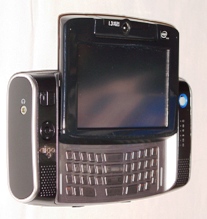Intel makes new mobile moves

BEIJING--Intel is making a dash for the next-generation mobile computing arena with its new processor platforms which the chipmaker says, will underpin ultramobile PCs (UMPC) and mobile Internet devices (MID).
Speaking at the Intel Developer Forum held here this week, David Perlmutter, Intel's senior vice president and general manager for mobility, said Intel will deliver the "Montevina" processor technology in 2008.
According to Perlmutter, the dual-core mobile processor will also be Intel's first 45-nanamoter Centrino chip and the first to offer integrated Wi-Fi and WiMax connectivity. With components that are about 40 percent smaller than previously available, Montevina will be ideal for mini- and sub-notebooks and will include integrated hardware decoding for high-definition video, Perlmutter said.
The Intel executive also noted that Intel's Santa Rosa platform will start shipping in notebooks from next month. The mobile platform will comprise an Intel Core 2 Duo processor, the mobile Intel 965 Express chipset family, 802.11n Wi-Fi connectivity and optional Intel Turbo memory that has been touted to improve application performance.
By the first half of 2008, Perlmutter said, the Santa Rosa platform will be upgraded to include the 45-nanometer Penryn mobile processor.
Anand Chandrasekhar, senior vice president and general manager of Intel's ultra mobility group, noted: "Today, you can only get the best Internet experience when you're tethered. But wireless Internet is revolutionary [and] it will change the way people live, play and work."
However, Chandrasekhar noted, cellphones today are poor mobile Internet devices with limited processing power and do not give users the same Internet experience that they get on a PC. "You need a device that is data-oriented to deliver the full Internet capability," he said.
That led Intel to introduce its new ultramobile platform, codenamed "McCaslin", for MIDs and UMPCs, Chandrasekhar added. Available later this year, the Intel Ultra Mobile platform 2007 is based on the Intel processor A100 and A110, the Intel 945GU Express chipset and the Intel ICH7U I/O controller hub, where computing power and processor package have been optimized for unique ultra-mobile computing requirements, he said.
Intel's UMPC platforms will be based on Microsoft's Windows Vista, though Chandrasekhar said Linux distributors Ubuntu and China's Red Flag Linux are expected to release UMPC versions of their open source operating systems at a later date.
"We will support both Windows and Linux to meet different customer needs," he said. "If they want a general PC experience, they may go for Windows; if they want an optimized Internet experience running multiple applications, they may choose Linux."
Asked if Microsoft's Windows Vista's systems requirements may be too high for the UMPC platform, Chandrasekhar said Intel has been working with Microsoft to optimize Windows Vista for the UMPC platform.
Next-gen ultra-mobile
By the first half of 2008, Intel will also introduce its next-generation "Menlow" ultra-mobile platform. Chandrasekhar said Menlow will include a new processor codenamed "Silverthorne", which will be based on a new 45-nanometer low-power chip microarchitecture.
 One of the ultramobile PCs showcased by Intel executives at IDF Beijing. |
The platform also includes the next-generation chipset, codenamed "Poulsbo". According to Chandrasekhar, Silverthorne and Poulsbo were both designed for MID and UMPC platforms.
In addition to support for WiMax connectivity, he noted that Intel-based UMPCs and MIDs will also be equipped with multiple communications technologies such as high speed downlink packet access (HSDPA). However, Chandrasekhar said, Intel believes that the best technology for wireless broadband--in terms of providing cost and power efficiency--will be WiMax.
The sweet spot price-point for UMPCs, which form factor lies between that of notebook PCs and smartphones, should range from US$400 to US$500, according to Chandrasekhar, although he expects the devices to initially cost about US$1,000. "But, over time, you'll see prices coming down."
Intel today also announced that it has established the Mobile Internet Innovation Alliance, which comprises original design manufacturers (OEMs) such as Asus, BenQ, Compal, Elektrobit, HTC, Inventec and Quanta. The alliance members will work together to address engineering challenges associated with delivering the full Internet experience users already enjoy on a PC to Intel-based MID form factors. Focus areas include power management, wireless communications and software integration. Members are expected to launch Menlow-based products in the first half of 2008.
Aaron Tan of ZDNet Asia reported from the Intel Developer Forum in Beijing, China.